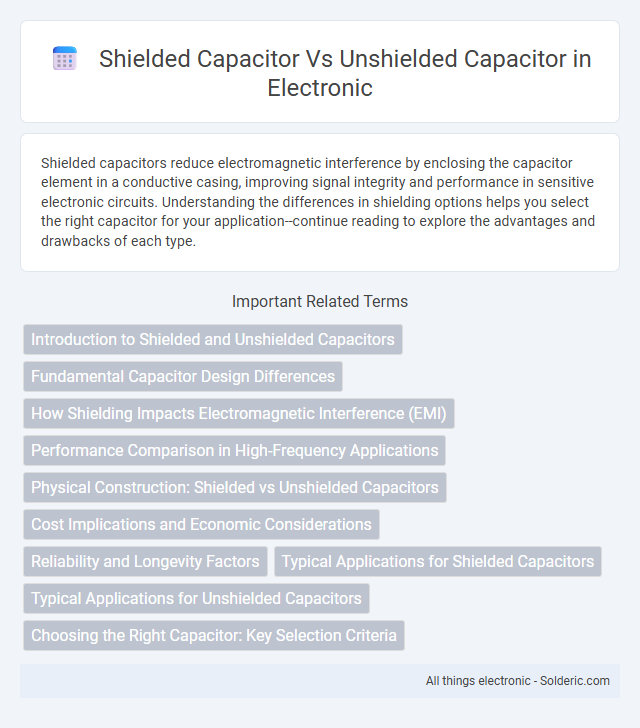Shielded capacitors reduce electromagnetic interference by enclosing the capacitor element in a conductive casing, improving signal integrity and performance in sensitive electronic circuits. Understanding the differences in shielding options helps you select the right capacitor for your application--continue reading to explore the advantages and drawbacks of each type.
Comparison Table
| Feature | Shielded Capacitor | Unshielded Capacitor |
|---|---|---|
| Electromagnetic Interference (EMI) Protection | High EMI shielding | Low EMI protection |
| Noise Reduction | Effective noise suppression | Limited noise reduction |
| Typical Applications | High-frequency circuits, RF modules, sensitive electronics | General-purpose circuits, less sensitive applications |
| Cost | Higher cost due to extra shielding | Lower cost, simpler design |
| Size | Usually larger because of the shield | Compact design |
| Reliability | Higher reliability in noisy environments | Suitable for low-interference environments |
Introduction to Shielded and Unshielded Capacitors
Shielded capacitors feature a metal casing or grounded conductive shield that minimizes electromagnetic interference and noise, enhancing performance in sensitive electronic circuits. Unshielded capacitors lack this protective barrier, making them more susceptible to external electrical noise but often smaller and less expensive for general applications. Selecting between shielded and unshielded capacitors depends on the specific requirements for noise reduction, size constraints, and cost efficiency in the design.
Fundamental Capacitor Design Differences
Shielded capacitors feature an internal metal shield separating the electrode and terminals from external electromagnetic interference, enhancing noise immunity and performance in sensitive circuits. Unshielded capacitors lack this protective barrier, making them more susceptible to EMI but typically offering lower cost and simpler construction. The fundamental design difference centers on the presence of the shielding layer, which influences the capacitor's reliability, noise reduction capabilities, and application suitability in high-frequency or precision environments.
How Shielding Impacts Electromagnetic Interference (EMI)
Shielded capacitors significantly reduce electromagnetic interference (EMI) by containing the electric field within the capacitor, preventing it from radiating to nearby components. This shielding minimizes noise coupling and improves signal integrity in high-frequency circuits. In contrast, unshielded capacitors are more prone to emit and pick up EMI, which can degrade performance in sensitive electronic applications.
Performance Comparison in High-Frequency Applications
Shielded capacitors exhibit superior performance in high-frequency applications due to their lower electromagnetic interference (EMI) and reduced parasitic inductance, resulting in improved signal integrity and stability. Unshielded capacitors, lacking a protective layer, tend to introduce higher noise levels and signal distortion, adversely affecting circuit reliability at elevated frequencies. The minimized stray capacitance and enhanced noise immunity of shielded capacitors make them ideal for RF circuits and sensitive communication systems.
Physical Construction: Shielded vs Unshielded Capacitors
Shielded capacitors feature an additional grounded metallic layer surrounding the dielectric and electrodes, reducing electromagnetic interference (EMI) and minimizing noise pickup in sensitive circuits. Unshielded capacitors lack this metal shield, making them more susceptible to external electric fields but often lighter and less expensive. Your choice between shielded and unshielded capacitors depends on the need for noise immunity versus cost and size constraints in your electronic design.
Cost Implications and Economic Considerations
Shielded capacitors generally incur higher manufacturing costs due to extra materials and complex production processes required for the shielding layer, impacting overall product pricing. Unshielded capacitors, being simpler in design and production, offer a more cost-effective solution for applications with lower sensitivity to electromagnetic interference. Economic considerations favor unshielded capacitors in high-volume, budget-sensitive projects, while shielded capacitors justify their higher cost through improved performance in noise-prone environments.
Reliability and Longevity Factors
Shielded capacitors offer enhanced reliability and longevity due to their protective casing that minimizes exposure to electromagnetic interference (EMI) and environmental contaminants, ensuring stable performance in harsh conditions. Unshielded capacitors are more susceptible to external noise and physical damage, which can lead to premature failure and inconsistent functionality over time. The shielding in capacitors improves insulation and reduces the risk of dielectric breakdown, directly contributing to extended operational life and higher durability in demanding applications.
Typical Applications for Shielded Capacitors
Shielded capacitors are typically used in sensitive electronic equipment where minimizing electromagnetic interference (EMI) is crucial, such as in medical devices, precision measurement instruments, and audio equipment. Their design reduces noise and crosstalk, enhancing performance in communication systems and high-frequency circuits. You can rely on shielded capacitors to improve signal integrity and reliability in environments with stringent EMI requirements.
Typical Applications for Unshielded Capacitors
Unshielded capacitors are commonly used in applications where electrical noise and interference are minimal, such as in low-frequency circuits, power supply filtering, and general-purpose electronic devices. They are ideal for cost-sensitive projects and environments with limited electromagnetic disturbance, providing reliable energy storage without the complexity of additional shielding. Your choice of an unshielded capacitor suits situations where size, cost, and performance balance without the need for enhanced noise suppression.
Choosing the Right Capacitor: Key Selection Criteria
When choosing between shielded and unshielded capacitors, consider factors such as electromagnetic interference (EMI) susceptibility, operating environment, and noise sensitivity. Shielded capacitors offer enhanced EMI protection and are ideal for high-frequency or sensitive electronic circuits, while unshielded capacitors suit applications with minimal interference risks and lower cost requirements. Evaluate dielectric material, capacitance stability, and physical size to ensure optimal performance and reliability in the final application.
shielded capacitor vs unshielded capacitor Infographic

 solderic.com
solderic.com